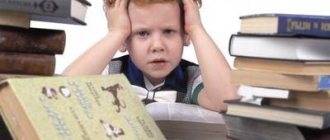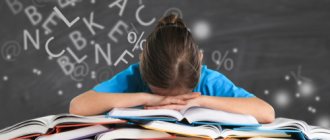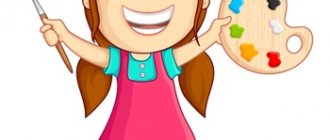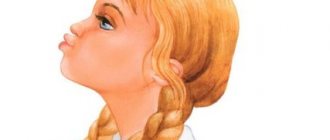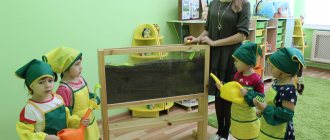Diagnosis of the state of written speech
Diagnosis of the state of written speech
Diagnosis of the state of written speech includes an examination of the processes of writing and reading. To determine the level of development of students' written language skills, the speech therapist analyzes the children's written work, noting the types, nature and severity of specific errors. The examination reveals both the level of development of writing by ear and the state of the skill of copying from handwritten and printed text.
Texts for diagnostic work are selected by a speech therapist taking into account the age of the children and the duration of training (beginning, middle, end of the school year). At the same time, they must be accessible and contain speech material rich in sounds of all phonetic groups, including words of different sound-syllable structures. For an in-depth examination of writing skills, students may be offered the following types of work.
Material for examining the condition of the letter
1. Write down the words written in handwritten font:
bream, beetle, snow, bow, mouse, arctic fox, skates, zebra, woodpecker, fly, carriage, T-shirt, autumn, evening, acorn, carriage, turkey, butterfly.
Depending on the age, the speech therapist teacher can highlight or underline the words necessary for copying.
2.Copy down the words written in printed font:
cloak, mole, stork, flag, insect, birch tree, ladder, student, crack, fun.
3.Write down lowercase letters from dictation:
b, g, e, g, c, s, x, m, yu, v, e, w, i, t, i.
Each letter must be written separately. If a child does not remember how to write a certain letter, a dash should remain instead.
For example: b,
__,
e, g,
__,
s, x,
etc.
4.Write down capital letters from dictation:
D, F, Ch, U, E, Shch, K, V, 3, G, S, R, L, C, B.
Each letter must be written separately. If a child does not remember how to write a certain letter, a dash should remain instead.
5. Write down the syllables from dictation:
or, mi, sya, up, ode, stu, window, angry, apt, zhde, croup, vle, stumps, asho, hvy, urn, koch, osta, zhadi, schatz.
6. Write down the words from dictation:
ball, chair, rook, writing, strength, book, truth, ball, grass, fell, birch, step, spring, sick, run away.
7.Write down a sentence after listening once:
has
a fluffy bunny.
8. Copy the printed text (grade 1).
Cat and bird
The cat was sleeping on the roof. A bird sat down next to the cat. Don't sit close, little bird, cats are cunning.
Depending on the age, the appropriate text is selected.
9. Copy handwritten text (2nd grade, beginning of the school year).
Puppy
to puppies. Masha and Petya took one. The puppy whined loudly. The children fed the puppy.
For students of other classes, more complex and voluminous texts are used.
10.Write a dictation (2nd grade, beginning of the school year).
Cat
Misha had a cat. The cat's name was Ryzhik. Ryzhik's tail is fluffy. The boy often played with the cat. They were friends.
Dictation texts, as in the previous task, are selected in accordance with age and duration of study.
11. Write down the names of the pictures.
Compose and write down a short story based on a picture or a series of plot pictures.
Students can complete the proposed tasks on an individual form.
Puppy
Zhuchka gave birth to puppies. Masha and Petya took one. The puppy whined loudly. The children fed the puppy.
__________________________________________________________________________________________________________________________________________
9. Write a printed text (2nd grade, beginning of the school year).
Cat and bird
The cat was sleeping on the roof. A bird sat down next to the cat. Don't sit close, little bird, cats are cunning.
__________________________________________________________________________________________________________________________________________
10. Write a dictation.
__________________________________________________________________________________________________________________________________________
11. Write the names of the pictures:
__________________________________________________________________________________________________________________________________________
12. Compose and write a short story based on the picture.
__________________________________________________________________________________________________________________________________________
Diagnostic dictations
to test writing skills
(proposed in the works of I.N. Sadovnikova, L. I, Tikunova)
In the forest
Here is a big forest. There is a river behind the forest. Children are walking there. And the buzzer is here. Zoya and Zhenya are looking for mushrooms. Yura and Yasha found the hedgehog.
On the river
It was summer. Zoya and Sasha went to the river. Zoya was picking flowers in the meadow. Sasha was fishing with a fishing rod. Here's Zhenya. Zhenya has a pike.
Cat
Misha had a cat. The cat's name was Ryzhik. Ryzhik's tail is fluffy. The boy often played with the cat. They were friends.
Maple
There was a maple tree growing near the house. Birds sat on maple branches. These are jackdaws. Seryozha gave them crumbs of bread and grain.
In the meadow
Ksyusha was in the meadow. There is tall grass all around. A bumblebee sat on a white porridge. It hummed menacingly. The girl was not afraid of him.
By the sea
I lived by the sea. The sound of the waves woke me up. During the day I loved watching them play. The white combs were beautiful.
School
This is our school. Lush asters grow at the entrance to the school. Wonderful roses grow in the flower beds. I like my school.
Ducks
Ducks are swimming. Olga and Alyosha throw pieces of bread to the birds. Soon the birds will leave the pond. They will fly away to warmer climes.
Meeting
Kolya was fishing. The reeds rustled. It crawled out onto the grass. The boy didn't touch him. I was already basking in the sun. Snakes are not poisonous.
Secret
I'm walking through the forest. There are many secrets and wonders in the forest. Here a fluffy tail flashed. Who was that? It was a squirrel jumping.
Cat Fedya
Yasha had a cat Fedya. The cat loved to play in the bushes. Yasha searched for the cat for a long time. And he was sitting on the roof.
Spring is coming
The sun is shining brighter. The snow has darkened. There are large puddles all around. Buds swelled on the branches. There is green grass on the lawns. Fast streams gurgle. Spring is coming.
The children were walking in the meadow. Seryozha and Lera were picking flowers. Sasha was picking sorrel. Misha has a net. He catches a butterfly. Time to have lunch. The children are going home.
The cat catches mice. The dog guards the house. The cow gives milk. The horse carries loads. Sheep provide wool and meat. Rabbit fur is used for fur coats and hats.
The car brought a lot of coal. We heat the stove with coal. Smoke is coming from the chimney. In winter there are severe frosts. Blizzards often blow. And the house is always warm.
Spring
April has arrived. The loose snow is melting. Streams gurgle all around. There is a large puddle on the porch. The kids put away their skates and skis. They are launching boats. Everyone is welcoming spring.
Children in the forest
The guys went out onto the lawn. It's nice in the forest in spring! The fragrant lily of the valley has bloomed. Birds are chirping. The children saw a hedgehog. He curled up into a ball. The guys won't touch the hedgehog.
Autumn soon
Autumn was approaching. It began to rain more often. The ground in the garden is already strewn with yellow leaves. The voices of songbirds are heard less frequently. They are preparing to fly to warmer climes.
Forester's hut
There lived a forester in the forest. The forester had a granddaughter, Sasha. Sasha had a good time with his grandfather. There was silence all around. Only the stream gurgled and the birds sang. Grasshoppers were chattering in the grass.
To the dacha
The children are going to the dacha. They will live with their grandmother. There is a grove there. There is a river behind the grove. Boys will fish, girls will pick flowers.
Birds
December has arrived. Fluffy snow fell. He covered the ground with a fluffy carpet. The river is frozen. The birds are hungry. They are looking for food. Children put bread and grains in the feeder. In summer, crops need protection. Birds will save the harvest.
Go hunting
In the morning I went into the grove with a gun and a dog. There was a wonderful silence. A hundred steps away you could hear a squirrel jumping on dry twigs. The fresh, fragrant air stung my eyes and cheeks pleasantly. A thin web stretched through the air. This is a sign of warm weather.
Who greeted winter like this?
The bats climbed into the hollow. The hedgehog covered himself with dry leaves. The frogs buried themselves in the moss. The bear sleeps in a den. The squirrel changed its coat for the winter and repaired its hollow. The fox made a bed out of leaves in a hole.
Holidays are coming soon
Holidays are coming soon. The children will go to camp. The day of departure has already been announced. Sasha will stay at home and go to the playground. Seryozha will go to the village. It's very nice there. His parents will go there on the weekend. There are many flowers there.
Brave Deed
Sasha Zhukov was walking home from school. The larks sang high in the sky. The road passed along the bank of the river. Suddenly Sasha saw that a little boy was drowning. He rushed into the water with his clothes on and pulled out the boy. The next day everyone learned about the student’s action. Sasha was thanked at the line.
Material for test copying by L.I. Tikunova
(beginning of the school year)
2nd grade
Mice
Old and small mice gathered at the mink. Their ears stick up and listen. The cat Vasya lies by the stove, waiting for the mice.
Cat and bird
The cat was sleeping on the roof. A bird sat down next to the cat. Don't sit close, little bird, cats are cunning.
(According to L. Tolstoy)
Autumn
Here it is September. The air is clean and fresh. Sounds can be heard far away in the forest. Thin honey mushrooms cluster on large old stumps.
3rd grade
Moscow
Many years ago, a small fortress was built on a high hill. Years passed. The fortress grew and became richer. More and more houses were built along the banks of the Moscow River. Trade people and merchants brought a lot of goods. The fortress became a great city - Moscow.
Yasnaya Polyana
There are many beautiful places in Rus'. Here is Yasnaya Polyana. Lev Nikolaevich Tolstoy was born and spent almost his entire life here. Here he planted a birch grove. Nice grove in early autumn! All of it costs gold. This was the writer's favorite place. He rested and worked here.
Dunno and the Beetle
One day Dunno was walking around the city and wandered into a field. At this time, a cockchafer was flying past. He'll go blind
body towards Dunno and hit him on the back of the head. Dunno fell to the ground. The beetle disappeared. Dunno stood up and looked around. It was quiet all around.
(According to N. Nosov)
4th grade
In Tsarskoe Selo
Alexander Sergeevich Pushkin studied at the Lyceum, which was located in Tsarskoye Selo near St. Petersburg. A beautiful, vast park began right under the windows of the lyceum. The sun's rays played freely in the heavy foliage of oaks and lindens. Marble statues gleamed white among the greenery. Birdsong could be heard everywhere. The water splashed quietly in the lake. Pushkin loved this ancient park very much and often walked in it.
Vladimir Ivanovich Dal
Vladimir Ivanovich Dal was a talented and hardworking person. His dictionary contains more than two hundred thousand words, thirty thousand proverbs, sayings, and riddles. Gathering material for his dictionary, Dal traveled all over Russia. He was even in Siberia and the Urals. Vladimir Ivanovich loved and understood his native language, and knew how to see beauty in the living Russian word. Dahl was a great friend of Pushkin.
October
The ancient Russian name for October is “gryaz-nik”. Autumn rains with sleet turned the ground into mush. In Rus', October was also called “leaf fall”, “golden autumn”, since it occurs at the time of yellowing of the foliage.
And how many autumn signs there were in Rus'! “Late leaf fall means a harsh winter.” “The willow was covered with silvery frost early - it will be a long winter.”
Based on the results of the examination, the teacher-speech therapist analyzes the nature and types of errors made by students, and completes study groups, draws up a class schedule, develops a correction program and conducts speech therapy classes.
Part 2. Writing and reading examination: a neuropsychological approach
Chapter 1. Methodology for examining the writing of junior schoolchildren
Inshakova O.B.
The examination of writing skills in primary school students is carried out using the following types of written work: auditory dictation, copying from printed and handwritten texts, and is carried out in each age group at least twice a year. To examine first-graders who have just entered school, a specially developed technique is used, which is more correctly called an “achievement test.”
A writing examination at the end of the first year of study and beyond is recommended to be carried out frontally, i.e. simultaneously for all students in the class, or in small subgroups of children enrolled in speech therapy. In this case, the experimental conditions will be the same for students. You should choose the same time for the examination, for example, the first half of the day.
To obtain the most objective results, you must adhere to the following conditions:
— Before carrying out written work, students need to be explained in detail the procedure for conducting the examination.
— First grade students must complete written assignments on unlined sheets at the beginning of their studies. Children should write their first and last name, the name of the type of written work (dictation, copying) and the title of the written work independently, as this is additional information material for assessing writing skills. At the end of the first year of study, in the second, third and fourth years of study, written work is written on regular notebook sheets.
— To study writing from dictation, only specially selected dictations of increased complexity are offered, but corresponding to the age and program requirements of students.
— In different classes or subgroups of children, dictation should be conducted by the same specialist (speech therapist or teacher).
— The text of the dictation should be read loudly, at the same speed, with clear articulation, but at the same time without pronouncing places in words that are difficult to write. The dictation is checked after writing.
— To copy from printed and handwritten texts, each student uses individual sheets of paper with test text samples.
— It is necessary to ensure that children sit alone at a desk and do not have the opportunity to look into their neighbors’ notebooks.
— Children who require outside help and fail to complete the task within the allotted time are recorded.
— The time required for dictation and copying is limited by the time frames allotted for these types of written work.
1.1. Studying the writing of first-graders at the beginning of education
This test was created to study the writing skills of former preschoolers. To conduct it, children are given sheets of white unlined A4 paper and simple pencils. The experimenter focuses the students' attention on the fact that test tasks can be both simple and complex. If the child cannot complete one of the tasks, then this task is allowed to be skipped and proceed to the next one.
Task 1. The task is aimed at learning how to write your first and last name independently. A horizontal line is drawn below in the free workspace, which can be used as a working line when completing a task. Children's attention to the presence of this line is not specifically fixed.
Procedure. The experimenter distributes examination protocols (A4 sheets) to the students and asks them to place them vertically in front of them. At the same time, the position of the sheet is shown on the board.
Instructions: “Circle the number 1. This is the first task.” Under the number 1, in the free space, write your first and last name as best you can.
This assignment allows you to learn:
1) level of familiarity with the basic principles of Russian writing (last name and first name are written according to spelling rules or using only the phonetic principle);
2) the presence of metalinguistic knowledge (writing first and last names with a capital letter, writing words separately);
3) the number and nature of errors (omissions, substitutions, confusion, etc.);
4) the child has visual-spatial difficulties (mirroring, failure to find the beginning of the working line and failure to use it when writing).
Task 2. Using this task, the number of letters of the alphabet independently reproduced by the child is studied. To complete it, as well as all subsequent tasks, children are not offered auxiliary horizontal lines to facilitate the arrangement of written material in the workspace, but are provided with a free workspace.
Procedure. The speech therapist asks to write as many printed letters as possible, known to the child. Providing assistance from outside during the execution of the task is excluded. The execution time is not limited.
Instructions: “Find and circle the number 2. This is the second task. Under task 2, in the free space, try to write all the printed letters that you know.”
This task allows you to determine:
1) the number of letters known to the child and available for correct reproduction from memory (consonants, vowels, b and b);
2) errors when performing the task;
3) visual-spatial difficulties (difficulty in finding the beginning of a line and the location of letters on a line, failure to hold the working line, fluctuations in the height and inclination of letters, the presence of specularity);
4) the ability to maintain a working program while writing (no transitions from printed letters to written ones);
5) the presence of macro- or micrography;
6) the presence of hyper- and hypotonicity.
Memorizing shapes – previous | next – Letter from dictation
Neuropsychological diagnostics, examination of writing and reading of primary schoolchildren
Consultation with a psychologist for neuropsychological problems
SURVEY OF READING AND WRITING IN JUNIOR SCHOOL CHILDREN
PREFACE
In modern conditions of increasing information flow, the role of reading and writing is constantly increasing as an activity that recreates experience and provides general educational training for a person, stimulates the development of the intellectual sphere and the personality as a whole.
During the period of primary schooling, reading and writing are transformed from a learning goal into a means of further acquisition of knowledge by students. Reading and writing are the basic skills on which all further learning is built. Reading and writing impairments often underlie academic failure and associated school maladjustment. All this determines the need for timely identification, prevention and elimination of reading and writing deficiencies in younger schoolchildren.
Currently, new forms of organizing the education of children with disorders of psychophysical development are emerging in the Republic of Belarus, and measures are being taken to develop a multi-level and variable system of special education. Among the fundamental conditions for implementing the task of comprehensive assistance to children and increasing the effectiveness of education, the need for unity in diagnosis and correction of disorders has been identified. Identifying and overcoming various disadvantages in a child’s development and educational activities cannot be the exclusive prerogative of any one specialist. Successful prevention, diagnosis and correction of various disorders, including reading and writing disorders, are possible with comprehensive qualified assistance from all teachers working with the child.
The main direction of overcoming educational disadvantages should be their prevention. It is important for the teacher to know the degree of development of the child’s reading and writing skills (mastery stage), the nature and causes of difficulties in mastering reading and writing. Diagnosing the level of development of educational skills allows you to choose an adequate educational route for the student and develop an optimal correction program.
Reading and writing disorders have different structures and degrees of severity. This is due to the variety of causes of these disorders, including: underdevelopment of oral speech in all its links (violations of sound pronunciation, phonemic perception, sound analysis and synthesis, vocabulary, grammatical structure, coherent speech); disturbances in motor functions of the hand, auditory-motor and visual-motor coordination; unformed cognitive motives for mastering reading and writing; imperfection of the voluntary sphere, lack of self-control, etc.
Reading and writing disorders and difficulties in mastering these skills can be local in nature (without combination with other disorders) or be a symptom of a more complex disorder (intellectual disability, visual defects, etc.). There are reading and writing disorders associated with impaired contact and communication between the child and the teacher. Some of the difficulties of schoolchildren in mastering reading and writing can be overcome directly by teachers of secondary schools and integrated education classes. But a significant part of reading and writing disorders is specific and persistent; Speech therapy assistance is required to correct them. The following terms are used to refer to these violations:
alexia (complete inability to learn reading);
dyslexia (specific partial reading disorder, manifested in repeated errors of a persistent nature);
agraphia (complete inability to master writing);
dysgraphia (a specific partial writing disorder in which persistent and repeated errors are observed).
As a rule, among children who study in general education schools (including in integrated education classes), students with alexia and agraphia are rarely found, while dyslexia and dysgraphia are quite often observed among both students in special and mainstream schools. Dyslexia and dysgraphia usually occur in combination. Their main symptom is the presence of specific (not related to the use of spelling rules) errors that are persistent and repeated. Typical examples of such errors are: substitutions, omissions, rearrangements, additions of letters, syllables, words when reading and writing; errors of prepositional case control (changes in case endings); errors in agreement between nouns and adjectives, verbs, etc.; separate writing of prefixes and continuous writing of prepositions; various deformations of sentences (violations of word order, omission of prepositions, etc.); reading comprehension disorders, etc.
Testing of reading and writing skills can be carried out by a teacher in order to determine the degree to which children have mastered these skills, taking into account the stage of learning at the time of the examination. When assessing the state of reading and writing, the standard indicators of reading technique, speed and writing literacy are the requirements of the school curriculum. In cases where specific reading and writing errors are identified in students, the teacher should contact a speech therapist who, in the process of targeted diagnostic work, will determine the nature and severity of reading and writing disorders, qualify the type of dyslexia and dysgraphia, and determine corrective measures.
The proposed manual includes methodological and practical materials for examining reading and writing in primary schoolchildren:
description of a series of tasks aimed at clarifying the formation of those operations that are necessary to carry out the processes of reading and writing at different stages of mastering skills;
tables for reading letters, syllables, words, phrases, stories;
sample texts of diagnostic dictations, presentations, plans and topics of essays.
The materials provided in the manual are not a test instrument or a standardized method for identifying reading and writing disorders. The volume of material and the duration of the examination are determined taking into account the individual characteristics of the student (age, year of study, performance, motivation, etc.). When selecting specific tasks from those offered, the teacher takes into account, as noted above, first of all the program requirements (for teaching literacy, reading and language). Therefore, speech therapists, like other specialists working with primary schoolchildren, must be well versed in the content of programs for various types of general education and special schools.
It should be noted that the examination of reading and writing should not be isolated. The level of mastery of reading and writing should be correlated with the state of the child’s oral speech, the characteristics of his cognitive and emotional-volitional sphere, and the personality as a whole. If difficulties in mastering these skills or the presence of dyslexic and dysgraphic errors are identified, the speech therapist teacher conducts a comprehensive examination.
For this purpose, he can use the scheme for examining the speech of a primary school student included in this manual.
The scheme
includes a description of the content of the study of general development, motor functions, oral and written speech of primary school students, as well as some
indicators for assessing
the results of the survey, including a reading and writing survey.
The manual is addressed to
speech therapists of general education and special schools of various types, as well as primary school teachers of general education and special schools and classes of various types, defectologists of integrated education classes and centers of correctional and developmental education and rehabilitation.
Can be used as an educational and methodological manual by students of defectology faculties, students of retraining and advanced training courses for educators. READING SURVEY
The reading survey is comprehensive
character.
When checking the state of reading skills in children, all
its
parameters
(method, accuracy, fluency, awareness) should be taken into account.
First, reading technique is examined, then reading comprehension. Reading is checked individually. You should not make any corrections or comments as you read. The examination materials used are specially selected texts that are accessible to the child in terms of volume and content,
but are not used in a classroom setting. It is advisable to begin checking the state of reading skills by presenting a short, coherent text. In case of difficulties, sentences, individual words, syllables of different structures are suggested. If the child does not have reading skills, he is presented with a set of letters to recognize them.
During the examination, it is necessary to find out at what stage of reading acquisition the child is, what difficulties he is experiencing, and what is the reason for them. Identified deficiencies and reading characteristics are compared
with data from a survey of oral speech and writing.
In order to prevent early diagnosis and correction of specific reading disorders (dyslexia) during the period of pre-school medical examination, you can use the “Methodology for Early Detection of Dyslexia” - MRVD (A. N. Kornev, 1997). MRDD (8 standardized tasks) allows you to identify children with a high risk of dyslexia, who should be examined in detail psychologically, pedagogically and speech therapy.
